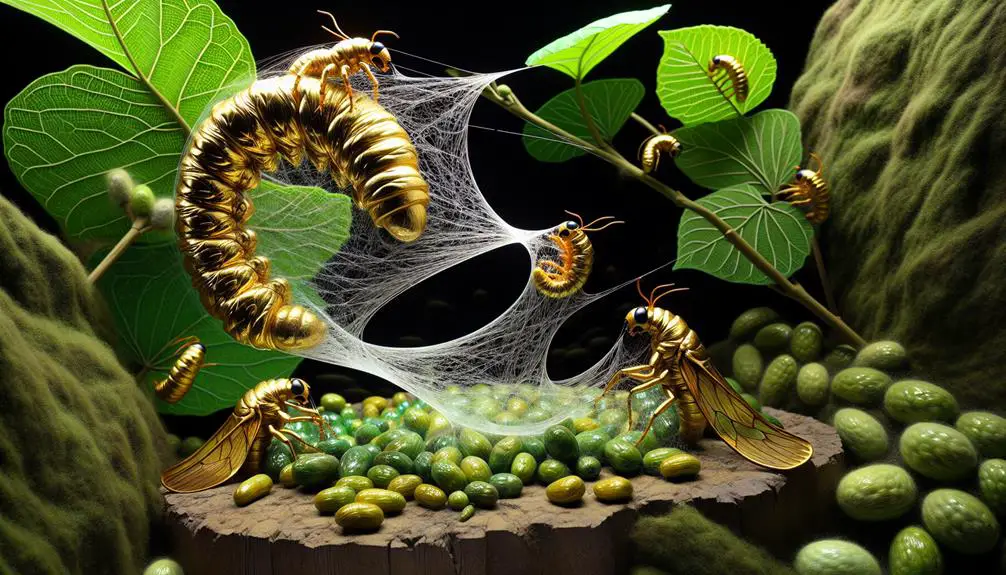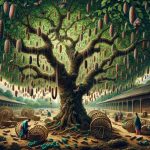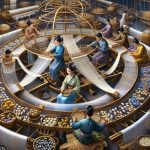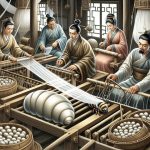Silk, a luxurious fabric, has origins in China and symbolizes wealth and power. It began in the Neolithic era and spread globally through the Silk Road. In the Ming Dynasty, intricate designs and rich textiles flourished. Today, silk is important in high-end fashion and various industries. China dominates silk production, supporting millions worldwide. Its versatility extends beyond clothing, playing roles in culture and industry. The introduction of silk traces back to China but holds a vast and diverse history, revealing its enduring significance and influence.
Table of Contents
Key Takeaways
- Silk originated in China during the Neolithic period.
- Sericulture began around the 4th millennium BC.
- China initially monopolized silk production.
- Silk spread beyond China through the Silk Road.
- Silk has a rich history as a symbol of wealth and power.
Origins of Silk
Silk, with its rich history dating back to the Neolithic period in China, has captivated cultures worldwide for centuries. The journey of silk began in China around the 4th millennium BC, where the luxurious fabric was first produced. This ancient art of silk production, known as sericulture, involved the cultivation of silkworms that fed on the leaves of the mulberry tree, spinning their cocoons into the fine threads that would later be woven into silk fabric.
During this period, China held a monopoly on silk production, keeping the techniques closely guarded. However, with the opening of the Silk Road in the first millennium BC, the secrets of silk slowly spread beyond China's borders, reaching distant lands and sparking a global fascination with this prized commodity. The expansion of silk cultivation to regions like Japan around 300 AD marked a significant milestone in the silk industry, paving the way for silk to become a cherished export and a symbol of luxury around the world.
Silk Road Connections
Let's chat about the Silk Road connections, where trade routes crisscrossed, linking the East and West.
This network wasn't just about goods; it also served as a bridge for cultural exchanges.
The Silk Road was a bustling highway of ideas, innovations, and economic prosperity between diverse civilizations.
Trade Routes
Connecting East and West, the network of trade routes known as the Silk Road facilitated the exchange of goods, ideas, and cultures.
The Silk Road was instrumental in spreading Chinese silk to distant lands, where it became a symbol of luxury and status.
This trade route wasn't limited to silk but also enabled the transportation of spices, precious metals, and exotic goods.
The Silk Road's impact extended far beyond commerce, fostering cultural exchange, technological advancements, and diplomatic relations between diverse civilizations.
The intricate web of connections along the Silk Road transformed societies and shaped the world as it's understood today.
Cultural Exchange
Cultural interactions blossomed along the Silk Road as Chinese silk traversed continents, weaving together diverse societies and fostering mutual understanding. China maintained a tight grip on silk production, with the coveted fabric's origins rooted in the country's mastery of raising silkworms on mulberry leaves. The silk trade wasn't merely about commerce but served as a conduit for cultural exchange. Through the exchange of silk textiles, traditions, beliefs, and artistic influences flowed freely. This cultural osmosis enriched societies along the vast trade routes, sparking innovation and appreciation for diverse customs. The Silk Road wasn't just a path for goods; it was a bridge connecting civilizations, nurturing a tapestry of shared experiences and mutual respect.
| China's Silk Production |
|---|
| Silkworms on Mulberry Leaves |
| Silk Trade |
Silk in Ming Dynasty
So, let's talk about the fascinating world of silk during the Ming Dynasty.
This period saw a remarkable influence on silk production methods, leading to the creation of intricate designs and richly colored textiles.
The Ming Dynasty truly elevated silk to a symbol of prestige and luxury, setting new standards in craftsmanship and quality.
Ming Dynasty Influence
During the illustrious Ming Dynasty, silk production thrived, showcasing intricate patterns, dragons, and flowers in luxurious fabrics. The Ming Dynasty's influence on silk was profound, shaping Chinese culture and diplomatic relations through its exquisite textiles.
Here are some key points highlighting the Ming Dynasty's impact on silk:
- Ming Dynasty silk textiles often featured elaborate designs for ceremonial purposes.
- Chinese silk weaving techniques reached new heights, emphasizing quality and craftsmanship.
- Ming Dynasty rulers used silk textiles as diplomatic gifts to enhance relations.
- Silk from the Ming Dynasty era represented a pinnacle of Chinese silk artistry.
- Innovative weaving techniques during this period revolutionized the silk industry.
Silk Production Methods
Exploring the silk production methods during the Ming Dynasty reveals the intricate weaving techniques and elaborate patterns that defined this era's silk craftsmanship. Silk weaving in the Ming Dynasty was characterized by detailed designs featuring dragons and flowers, especially showcased in ceremonial robes. This period marked a peak in silk production, with the industry flourishing and contributing notably to the cultural richness and luxury associated with Chinese silk.
The techniques developed during the Ming Dynasty influenced silk weaving traditions and craftsmanship in China for years to come. Silk played a pivotal role in diplomatic exchanges, symbolizing status and power. The Ming Dynasty's emphasis on quality and artistry elevated silk production to new heights, reflecting the cultural sophistication of the era.
Silk in Modern Industry
Have you ever wondered why silk remains a highly valued luxury material in modern industry? As someone passionate about mastering the intricacies of silk, I find the role of this exquisite fabric in contemporary settings truly fascinating.
Here are some compelling reasons why silk continues to hold its prestigious status in the modern world:
- High-End Fashion: Silk is prominently featured in the creations of renowned fashion houses, showcasing its elegance and luxurious appeal.
- Textile Industries: The textile sector relies on silk for producing premium-quality fabrics that stand out for their softness and luster.
- Sericulture Advancements: Modern sericulture techniques have revolutionized silk production, making it more efficient and sustainable.
- Unique Properties: Silk's exceptional properties, such as its lightweight nature and natural sheen, make it a preferred choice for various applications.
- Luxurious Feel: The incomparable luxurious feel of silk sets it apart, offering a touch of sophistication to everything it embellishes.
In the domain of modern industry, silk continues to captivate with its timeless allure and versatility.
Major Silk Producers Today
Silk's global significance extends to the present day, with China emerging as the largest producer of silk, responsible for about 70% of the world's silk output. While China leads the way, other major silk producers like India, Brazil, North Korea, Thailand, and Vietnam also play important roles in the global silk production industry. The silk industry not only supports approximately 34 million people worldwide but also contributes greatly to the economies of these countries.
One fascinating aspect of the silk industry is how traditional silk weaving skills have been passed down through generations. These skills aren't only a proof of the rich cultural heritage associated with silk production but also serve as a means of maintaining economic stability in rural communities. The evolution of the silk industry from ancient times to the present day highlights its enduring importance in global trade and fashion, making it a crucial component of many economies worldwide.
Significance of Silk
Why is silk considered a luxury fabric with unique properties sought after worldwide?
Silk holds immense significance due to its exceptional qualities that have captivated civilizations for centuries. Let's explore why this fabric is so highly valued:
- Economic Impact: Silk production supports 34 million people globally, providing economic stability in rural communities.
- Cultural Heritage: Silk weaving skills have been passed down through generations, showcasing a rich cultural legacy.
- Global Production: Main silk-producing countries like China, India, Brazil, North Korea, Thailand, and Vietnam play a pivotal role in meeting worldwide demand.
- Versatile Usage: Silk isn't limited to clothing; it has been used for writing and as a symbol of social status throughout history.
- Unique Origins: The intricate process of silk production, starting from mulberry leaves to silk worm cultivation, contributes to its exclusivity.
These aspects collectively contribute to silk's allure, making it a fabric of choice for those seeking luxury, sophistication, and a touch of history in their textiles.
Frequently Asked Questions
What Is the General Introduction of Silk?
Sure, let's talk about the general introduction of silk. Originating in China, silk is a luxurious natural fiber made from fibroin. It gained fame along the Silk Road and continues to be prized for its beauty and elegance.
How Is Silk Described?
Describing silk involves highlighting its natural protein fiber composition, particularly fibroin, produced mainly by insects like the mulberry silkworm. Its sheen, absorbance, and strength compared to steel are remarkable characteristics that make silk unique.
What Is the Description of Silk Fabric?
Silk fabric is a luxurious natural material made from fibroin proteins. It is obtained from silkworms like the mulberry silkworm. Silk's history spans millennia, with intricate textiles found in ancient tombs. Its production involves insects and has evolved over time.
Who Begins Wearing Silk First and Why?
I begin wearing silk first as a symbol of luxury and status. Its exquisite feel and exclusivity made it desirable for Chinese emperors and nobles. Silk's history spans over 8,500 years, showcasing its prestigious allure.
- How Does Ring Spun Cotton Affect Garment Fit and Shape Retention? - August 13, 2024
- What Are the Challenges in Producing Ring Spun Cotton? - August 13, 2024
- Is Ring Spun Cotton Suitable for Plus-Size Clothing? - August 13, 2024







